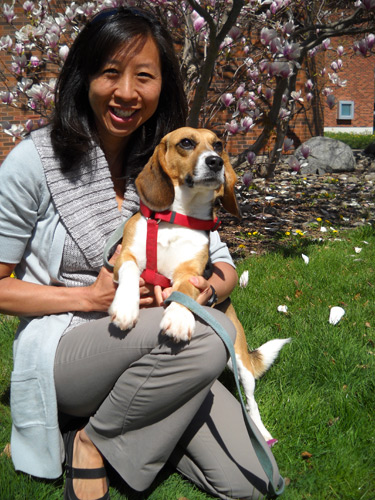
There are plenty of veterinarians in Ottawa but few with clients like Michelle Lem’s. For the past seven years, the Guelph DVM grad has provided vet services for the pets of people living on the streets and in homeless shelters.
Now, besides running a busy veterinary outreach program in Canada’s capital, she’s midway through a master’s degree at her alma mater intended to improve lives for homeless and at-risk youths and their pets. Along with population medicine professor and former DVM classmate Jason Coe, Lem is studying the effects of pet ownership on young people who are homeless or at risk. She says this special case of the human-animal bond may affect pet owners’ prospects for surviving life on the streets or perhaps finding a way into more stable lives.
An estimated 20 per cent of homeless people, including people moving between the street and shelters, have pets, according to one recent study in Toronto.
Not that you’d learn that by observing people in shelters or visiting food banks or other mission services, says Lem. Those institutions often ban animals, compounding problems for their owners, who often would rather forgo services than abandon their pets. “It’s a hidden problem,” she says.
She began running free mobile vet clinics for homeless people seven years ago, basically by loading up her car with supplies and providing on-the-spot preventive care. The Mission Veterinary Care Program now runs at the Ottawa Mission for the homeless and at Operation Come Home, a drop-in centre for homeless teens and young adults. On a volunteer basis, she’s also driven her “clinic” to destinations such as the Six Nations reserve near Hamilton.
She and a team of about 25 volunteer veterinarians and technicians have seen about 1,100 animals in Ottawa. Surprisingly, many clients return their pets for check-ups and preventive care, including vaccinations and parasite treatment. Others are truly transient. One woman in her 60s visited the clinic often with her cat and her cocker spaniel, but she hasn’t appeared in months.
“When I don’t see them, I worry about them,” says Lem.
Most of the patients are dogs, although many clients bring cats. Lem recalls one woman who showed up in a wheelchair with a blanket draped over a bulky object before her. After removing the blanket, Lem discovered that the woman had strapped three cat carriers containing six cats to her wheelchair. Lem vaccinated the animals and eventually persuaded the visitor to find homes for two of them.
None of her clients has much money, of course. But she still expects them to try to treat their animals properly. She’s often able to recommend relatively cheap treatment ― say, cleaning a dog’s teeth with baking soda or cleaning ears with vinegar and water.
“I see them as relationships,” she says of her clients. “I don’t see them as charity. They take ownership and responsibility. They’re proud of the fact that they take care of their pet. All they’re lacking is access to knowledge and education to do it better.”
About 18 months ago, Lem assembled a board of directors and attained non-profit status for the program. Last year, Coe contacted her about new research funding for the Ontario Veterinary College (OVC) to study pet ownership among homeless youths. He’s interested in the human-animal bond and in social factors affecting both human and animal health. The project may form the basis for further collaboration with researchers in Guelph’s College of Social and Applied Human Sciences.
“There’s not a lot of focus on the relationship between homeless youth and their animals,” says Coe. “We need to better understand the relationship between people and their pets to see about positive impacts.”
Having spent the past year taking courses here, Lem will now spend another year studying the human-animal bond among homeless clients in Ottawa and several other cities. She says relationships with animals may help in reaching and treating people with mental health or drug problems. Many people who died during Hurricane Katrina in New Orleans had refused to abandon their pets, she says; an example of the strength of the human-animal bond.
Referring to homeless people, Coe says: “Through their pets, they’re accessing vet services. If we can work with other health-care professionals, can we also increase their access to other health-care services and providers?”
Lem’s work with the homeless may also help in dealing with other pet owners who are marginalized by old age, poverty, disability or violence. For example, she was a founding member of Ottawa’s Network for Women with Pets Escaping Violence and hopes other communities will replicate her organization.
She has also taught in the veterinary technician and assistant programs at Algonquin College and has consulted in animal behaviour at Ottawa’s Bayview Animal Hospital.